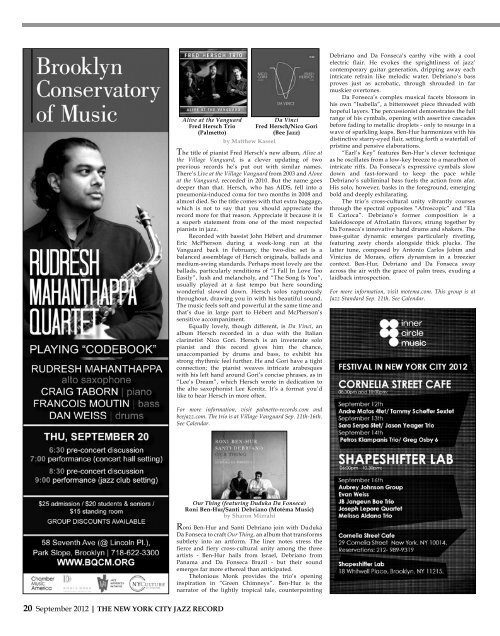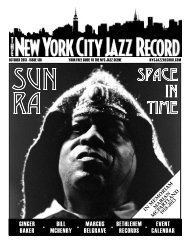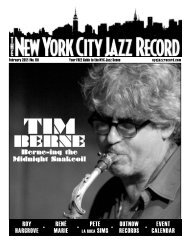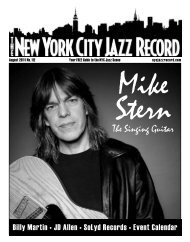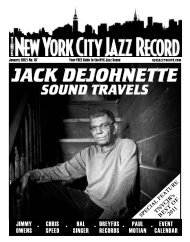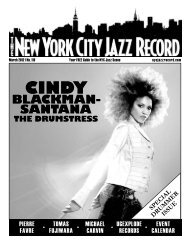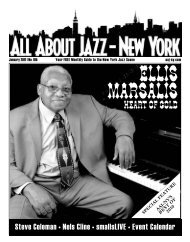September 2012 - The New York City Jazz Record
September 2012 - The New York City Jazz Record
September 2012 - The New York City Jazz Record
Create successful ePaper yourself
Turn your PDF publications into a flip-book with our unique Google optimized e-Paper software.
Alive at the Vanguard<br />
Fred Hersch Trio<br />
(Palmetto)<br />
20 <strong>September</strong> <strong>2012</strong> | THE NEW YORK CITY JAZZ RECORD<br />
by Matthew Kassel<br />
Da Vinci<br />
Fred Hersch/Nico Gori<br />
(Bee <strong>Jazz</strong>)<br />
<strong>The</strong> title of pianist Fred Hersch’s new album, Alive at<br />
the Village Vanguard, is a clever updating of two<br />
previous records he’s put out with similar names.<br />
<strong>The</strong>re’s Live at the Village Vanguard from 2003 and Alone<br />
at the Vanguard, recorded in 2010. But the name goes<br />
deeper than that. Hersch, who has AIDS, fell into a<br />
pneumonia-induced coma for two months in 2008 and<br />
almost died. So the title comes with that extra baggage,<br />
which is not to say that you should appreciate the<br />
record more for that reason. Appreciate it because it is<br />
a superb statement from one of the most respected<br />
pianists in jazz.<br />
<strong>Record</strong>ed with bassist John Hébert and drummer<br />
Eric McPherson during a week-long run at the<br />
Vanguard back in February, the two-disc set is a<br />
balanced assemblage of Hersch originals, ballads and<br />
medium-swing standards. Perhaps most lovely are the<br />
ballads, particularly renditions of “I Fall In Love Too<br />
Easily”, lush and melancholy, and “<strong>The</strong> Song Is You”,<br />
usually played at a fast tempo but here sounding<br />
wonderful slowed down. Hersch solos rapturously<br />
throughout, drawing you in with his beautiful sound.<br />
<strong>The</strong> music feels soft and powerful at the same time and<br />
that’s due in large part to Hébert and McPherson’s<br />
sensitive accompaniment.<br />
Equally lovely, though different, is Da Vinci, an<br />
album Hersch recorded in a duo with the Italian<br />
clarinetist Nico Gori. Hersch is an inveterate solo<br />
pianist and this record gives him the chance,<br />
unaccompanied by drums and bass, to exhibit his<br />
strong rhythmic feel further. He and Gori have a tight<br />
connection; the pianist weaves intricate arabesques<br />
with his left hand around Gori’s concise phrases, as in<br />
“Lee’s Dream”, which Hersch wrote in dedication to<br />
the alto saxophonist Lee Konitz. It’s a format you’d<br />
like to hear Hersch in more often.<br />
For more information, visit palmetto-records.com and<br />
beejazz.com. <strong>The</strong> trio is at Village Vanguard Sep. 11th-16th.<br />
See Calendar.<br />
Our Thing (featuring Duduka Da Fonseca)<br />
Roni Ben-Hur/Santi Debriano (Motéma Music)<br />
by Sharon Mizrahi<br />
Roni Ben-Hur and Santi Debriano join with Duduka<br />
Da Fonseca to craft Our Thing, an album that transforms<br />
subtlety into an artform. <strong>The</strong> liner notes stress the<br />
fierce and fiery cross-cultural unity among the three<br />
artists - Ben-Hur hails from Israel, Debriano from<br />
Panama and Da Fonseca Brazil - but their sound<br />
emerges far more ethereal than anticipated.<br />
<strong>The</strong>lonious Monk provides the trio’s opening<br />
inspiration in “Green Chimneys”. Ben-Hur is the<br />
narrator of the lightly tropical tale, counterpointing<br />
Debriano and Da Fonseca’s earthy vibe with a cool<br />
electric flair. He evokes the sprightliness of jazz’<br />
contemporary guitar generation, dripping away each<br />
intricate refrain like melodic water. Debriano’s bass<br />
proves just as acrobatic, through shrouded in far<br />
muskier overtones.<br />
Da Fonseca’s complex musical facets blossom in<br />
his own “Isabella”, a bittersweet piece threaded with<br />
hopeful layers. <strong>The</strong> percussionist demonstrates the full<br />
range of his cymbals, opening with assertive cascades<br />
before fading to metallic droplets - only to resurge in a<br />
wave of sparkling leaps. Ben-Hur harmonizes with his<br />
distinctive starry-eyed flair, setting forth a waterfall of<br />
pristine and pensive elaborations.<br />
“Earl’s Key” features Ben-Hur’s clever technique<br />
as he oscillates from a low-key breeze to a marathon of<br />
intricate riffs. Da Fonseca’s expressive cymbals slow<br />
down and fast-forward to keep the pace while<br />
Debriano’s subliminal bass fuels the action from afar.<br />
His solo, however, basks in the foreground, emerging<br />
bold and deeply exhilarating.<br />
<strong>The</strong> trio’s cross-cultural unity vibrantly courses<br />
through the spectral opposites “Afroscopic” and “Ela<br />
E Carioca”. Debriano’s former composition is a<br />
kaleidoscope of AfroLatin flavors, strung together by<br />
Da Fonseca’s innovative hand drums and shakers. <strong>The</strong><br />
bass-guitar dynamic emerges particularly riveting,<br />
featuring zesty chords alongside thick plucks. <strong>The</strong><br />
latter tune, composed by Antonio Carlos Jobim and<br />
Vinicius de Moraes, offers dynamism in a breezier<br />
context. Ben-Hur, Debriano and Da Fonseca sway<br />
across the air with the grace of palm trees, exuding a<br />
laidback introspection.<br />
For more information, visit motema.com. This group is at<br />
<strong>Jazz</strong> Standard Sep. 11th. See Calendar.


